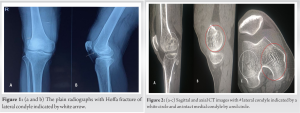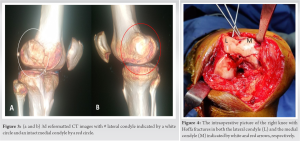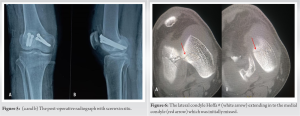It is very important to carefully scrutinize the computed knee tomography in a case of unicondylar Hoffa fracture, to rule out bicondylar involvement.
Dr. Phani Krishna Karthik Yelamarthy, Department of Orthopaedics, Udaiomni Hospital, Hyderabad, Telangana, India. E-mail: dryelamarthykarthik@gmail.com
Introduction: The Hoffa fracture is an uncommon coronal plane fracture involving the femoral condyles. The coronal nature of the fracture makes it hard to diagnose clinic-radiologically.
Case Report: A 42-year-old male patient developed pain associated with swelling in his right knee after a two-wheeler accident. He consulted his general practitioner who missed the Hoffa fracture on plain radiographs and treated him conservatively with analgesics. The pain did not subside and he visited our emergency department where a computed tomography (CT) scan revealed a Hoffa fracture of the lateral condyle. He was taken up for open surgery, and while fixing the lateral condylar fracture, we found an undisplaced medial condylar Hoffa fracture of the ipsilateral femur. This fracture was initially missed on the CT scan. Both the fractures were internally fixed and the patient was put on rehabilitation. At the end of the 6-month follow-up, the patient had a full knee range of motion.
Conclusion: Careful and detailed CT imaging and looking for fractures other than Hoffa is important, so as not to miss any associated bony injuries. Furthermore, the treating surgeon needs to look for other bony injuries during open or arthroscopic fixation of Hoffa’s fracture.
Keywords: Hoffa, bicondylar, fracture, missed, intraoperative, CT.
Hoffa fractures account for <1% of the fractures involving the distal femur [1]. These fractures usually occur after high-energy trauma and involve the posterior femoral condyles in the coronal plane. The displaced fracture pattern of the lateral condyle was first mentioned by Hoffa in 1904, thus named accordingly [2]. The muscular pull by the popliteus and gastrocnemius makes these fractures unstable and they tend to heal with a valgus (lateral condyle Hoffa #) or varus (medial condyle Hoffa#) deformity, if not managed appropriately [1]. Hence the treating physician should be very cautious not to miss these fractures as they tend to get displaced and get malunited if not internally fixed [3]. We report a case of lateral condylar Hoffa fracture with a missed medial condylar Hoffa fracture on pre-operative radiological imaging.
A 42-year-old male patient came to the emergency department of a primary care center after being hit by a car while traveling on a two-wheeler. He managed to walk after a fall but, complained of pain and swelling of the right knee and was prescribed analgesics and was sent home. On the following day, he visited our outpatient department as he experienced excruciating right knee pain. He was evaluated with plain radiographs and a diagnosis of Hoffa’s fracture was suspected (Fig. 1).


The lateral condylar Hoffa fracture is commoner than the medial counterpart and the bi-condylar Hoffa fractures are very rare [4]. These fractures usually occur after road traffic accidents and are mostly seen in young individuals. The Hoffa fracture is obscured on the anteroposterior plain radiograph by the intact anterior condyle and hence gets easily missed despite the presence of clinical findings suggesting a distal femur fracture [5]. Moreover, a bicondylar Hoffa fracture can easily be missed on plain radiographs and a three-dimensionally reconstructed CT imaging is usually advocated for not missing those injuries [6]. In our case, the medial condylar Hoffa was not appreciable even on 3D reconstruction imaging and is incidentally identified intraoperatively. We then retrospectively reviewed the imaging and noticed a very faint fracture line in the axial CT imaging (Fig. 6). To date, there is only a handful of cases reported in the literature with bicondylar Hoffa fractures [7, 8, 9, 10, 11, 12]. However, in all these cases published in the literature, the bicondylar Hoffa fractures were very obvious in the pre-operative imaging performed. Magnetic resonance imaging is not routinely done at our setup for traumatic fractures, and had it been done we might have diagnosed the bicondylar Hoffa fracture preoperatively. Our case is unique in that both the radiologist and the operating surgeon missed the faint fracture of the medial condyle on pre-operative imaging. High clinical suspicion and CT imaging (conventional and 3D reconstructed) and internal fixation provide better outcomes for these injuries. It has become prudent for the surgeon to look for associated injuries intraoperatively.
Hoffa fractures are relatively rare and can be easily missed radiologically. Careful and detailed CT imaging and looking for fractures other than Hoffa’s are important so as not to miss associated bony injuries. The treating surgeon needs to look for other bony injuries during open or arthroscopic fixation of Hoffa’s fracture.
A CT scan is always warranted whenever a Hoffa fracture is clinically suspected. The radiologist and the treating surgeon should always be skeptical to rule out a bicondylar Hoffa in an obviously unicondylar Hoffa fracture by detailed evaluation of the CT imaging.
References
- 1.Patel PB, Tejwani NC. The Hoffa fracture: Coronal fracture of the femoral condyle a review of literature. J Orthop 2018;15:726-31. [Google Scholar]
- 2.Hoffa A. Lehrbuch der Frakturen und Luxationen für. 4th ed. Stuttgart: Ferdinand Enke-Verlag; 1904. [Google Scholar]
- 3.Zhou Y, Pan Y, Wang Q, Hou Z, Chen W. Hoffa fracture of the femoral condyle: Injury mechanism, classification, diagnosis, and treatment. Medicine (Baltimore) 2019;98:e14633. [Google Scholar]
- 4.Ul Haq R, Modi P, Dhammi I, Jain AK, Mishra P. Conjoint bicondylar Hoffa fracture in an adult. Indian J Orthop 2013;47:302-6. [Google Scholar]
- 5.Papadopoulos AX, Panagopoulos A, Karageorgos A, Tyllianakis M. Operative treatment of unilateral bicondylar Hoffa fractures. J Orthop Trauma 2004;18:119-22. [Google Scholar]
- 6.Neogi DS, Singh S, Yadav CS, Khan SA. Bicondylar Hoffa fracture-a rarely occurring, commonly missed injury. Injury Extra 2008;39:296-8. [Google Scholar]
- 7.Lee SY, Niikura T, Iwakura T, Sakai Y, Kuroda R, Kurosaka M. Bicondylar hoffa fracture successfully treated with headless compression screws. Case Rep Orthop 2014;2014:139897. [Google Scholar]
- 8.Dua A, Shamshery PK. Bicondylar Hoffa fracture: Open reduction internal fixation using the swashbuckler approach. J Knee Surg 2010;23:21-4. [Google Scholar]
- 9.Sharath RK, Gadi D, Grover A, Gour SK. Operative treatment of isolated bicondylar Hoffa fracture with a modified swashbuckler approach. Arch Trauma Res 2015;4:e25313. [Google Scholar]
- 10.Arya A, Arya S, Jindal M, Garg A, Sandhu N. Bicondylar Hoffa fracture in a young male: A rare case. Orthop Rheumatol Open Access J 2019;15:555901. [Google Scholar]
- 11.Mounasamy V, Hickerson L, Fehring K, Desai P. Open bicondylar Hoffa fracture with patella fracture: A case report and literature review. Eur J Orthop Surg Traumatol 2013;23 Suppl 2:261-5. [Google Scholar]
- 12.Lal H, Bansal P, Khare R, Mittal D. Conjoint bicondylar Hoffa fracture in a child: A rare variant treated by minimally invasive approach. J Orthop Traumatol 2011;12:111-4. [Google Scholar]











